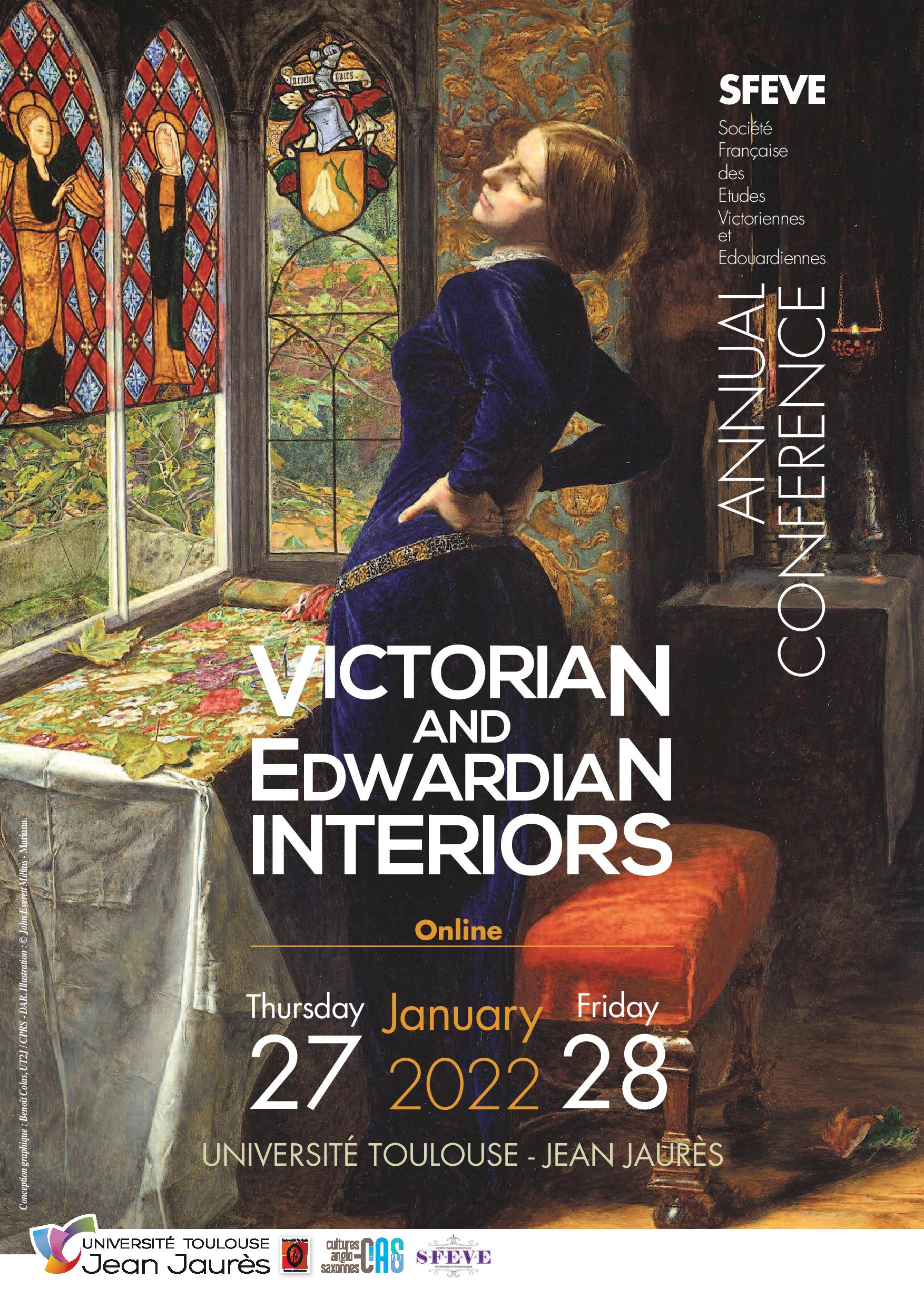-
Partager cette page
Victorian and Edwardian Interiors
Publié le 13 décembre 2021 – Mis à jour le 13 décembre 2021
du 27 janvier 2022 au 28 janvier 2022
9h-17h30
En ligne / Amphi F417 (Maison de la Recherche, UT2J)
As we gradually come out of a long period of enforced global confinement which has challenged us, amongst other things, to take a ‘journey round [our] room[s]’ (Xavier de Maistre) and reconsider our assumptions about inside and outside, the 2022 SFEVE conference invites scholars to look afresh at the historical emergence, material manifestations and cultural significance of the interior in the long nineteenth century. Building on recent interdisciplinary research in material studies, architectural design theory, the Victorian architectural imaginary and the poetics, politics and phenomenology of dwelling, this conference seeks to explore the multiple facets of the interior from the beginning of the nineteenth century to the end of the Edwardian era.
Central to the concept of ‘interior’ is the imbrication of the word’s spatial, physical, emotional, mystical and political meanings. ‘Interior’ came into use in the English language in the sixteenth century to mean inside as divided from outside, but also more specifically to describe the deeper, more spiritual nature of the soul within the body. Derived from the Latin ‘intus’ (i.e. ‘within’), ‘interior’ is a comparative form, whose meaning is accentuated in the superlative ‘intimus’ (i.e. innermost, deepest, most secret, most private). From the early eighteenth century, ‘interiority’ was used to evoke inner character and individual subjectivity. But from the middle of the eighteenth century the ‘interior’ was also a geo-political term used to refer to the domestic affairs of a state and to the territory that belongs to a country. It was only at the beginning of the nineteenth century that, according to the _Oxford English Dictionary_, the ‘interior’ came to mean ‘the inside of a building or room especially in reference to the artistic effect; also a picture or representation of the inside of a building. Also, in a theatre, a “set” consisting of the inside of a building or room.’
Thus, as Charles Rice notes, the nineteenth-century interior is inherently double, both a physical three-dimensional space and at the same time an image—a painting, print, theatrical backdrop—which can ‘be imagined and dreamed, and inhabited as such’ (2). While nineteenth-century conceptualizations of the interior were clearly linked to important questions of public health, territorial expansion, historical knowledge and the exploration of the body, subjectivity and the unconscious, the Victorians thus foregrounded the idea of the interior’s deliberate and artful constructedness. In some of the commemorative colour prints of colonial interiors on display at the Crystal Palace in 1851, for example, the theatricality of the interior is regularly emphasized through the presence of visitors/spectators peering through drawn curtains. [...]
Full call for papers available here.
Central to the concept of ‘interior’ is the imbrication of the word’s spatial, physical, emotional, mystical and political meanings. ‘Interior’ came into use in the English language in the sixteenth century to mean inside as divided from outside, but also more specifically to describe the deeper, more spiritual nature of the soul within the body. Derived from the Latin ‘intus’ (i.e. ‘within’), ‘interior’ is a comparative form, whose meaning is accentuated in the superlative ‘intimus’ (i.e. innermost, deepest, most secret, most private). From the early eighteenth century, ‘interiority’ was used to evoke inner character and individual subjectivity. But from the middle of the eighteenth century the ‘interior’ was also a geo-political term used to refer to the domestic affairs of a state and to the territory that belongs to a country. It was only at the beginning of the nineteenth century that, according to the _Oxford English Dictionary_, the ‘interior’ came to mean ‘the inside of a building or room especially in reference to the artistic effect; also a picture or representation of the inside of a building. Also, in a theatre, a “set” consisting of the inside of a building or room.’
Thus, as Charles Rice notes, the nineteenth-century interior is inherently double, both a physical three-dimensional space and at the same time an image—a painting, print, theatrical backdrop—which can ‘be imagined and dreamed, and inhabited as such’ (2). While nineteenth-century conceptualizations of the interior were clearly linked to important questions of public health, territorial expansion, historical knowledge and the exploration of the body, subjectivity and the unconscious, the Victorians thus foregrounded the idea of the interior’s deliberate and artful constructedness. In some of the commemorative colour prints of colonial interiors on display at the Crystal Palace in 1851, for example, the theatricality of the interior is regularly emphasized through the presence of visitors/spectators peering through drawn curtains. [...]
Full call for papers available here.
Partenaires :
Société Française des Etudes Victoriennes et Edouardiennes

